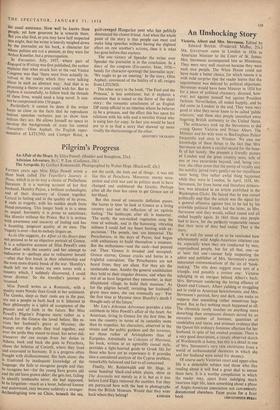An linshocking Story
Victoria, Albert and Mrs. Stevenson. Edited by Edward Boykin. (Frederick Muller, 25s.) MR. STEVENSON came to London in 1836 as American Minister to the Court of St. James. Mrs. Stevenson accompanied him as Ministress. They were very well received because they were such nice people. The White House could not have made a better choice, for which reason it is with mild surprise that the reader learns that the appointment was delayed by political objections. Stevenson would have been Minister in 1834 but for a piece of political chicanery, directed, how- ever, not against himself but against President Jackson. Nevertheless, all ended happily, and he did come to London in the end. They were very good at what they never knew to be called 'public relations,' and these nice people smoothed away lingering British animosity to the United States.
The aristocracy took up the Stevensons as did young Queen Victoria and Prince Albert. The Minister and his wife went to Buckingham Palace frequently and once to Windsor. We owe our knowledge of these things to the fact that Mrs. Stevenson set doWn a careful record for the bene- fit of her family. She presents a friendly picture of London and the great country seats, tells of one or two excursions beyond, and, being very nice, she often notes that the pomp of royalty and the nobility jarred (very gently) on her republican inner being. One rather awful thing happened while they were in London. In April, 1838, Mr. Stevenson, far from home and therefore defence. less, was attacked in an article published in the Washington Globe. He feared that he was ruined politically and that the article was the signal for a general offensive against him to be led by his erstwhile political friends, but the latter, as Mrs. Stevenson said they would, rallied round and all ended happily again. In 1841 these nice people had to leave, for the perfectly respectable reason that their term of duty had ended. That is the story.
It is well for some of us to be reminded how wholesomely mild Anglo-American relations can be, especially when they are conducted by nice, unprejudiced people, but for all that, one—or at least this one—cannot help suspecting the editor and publisher of Mrs. Stevenson's utterly innocuous communications of the sin of 'book- making.' The title does suggest some sort of a triangle, and possibly a sinister one : Victoria indulging in an intrigue behind Albert's back; Mrs. Stevenson sundering the loving alliance of Queen and Consort; Albert yielding or struggling not to yield to American bewitchments, and Mrs. Stevenson's portrait, fiery and dark, can make us suppose that something rather monstrous hap- pened. But in fact nothing much happened at all. The chronicle rarely touches on anything more disturbing than sumptuous dinners served by an excessive number of footmen, quantities of candelabra and tiaras, and intimate evidence that the Queen felt ordinary feminine affection for her husband, in spite of her exalted position. There is a very good description, a closely observed sketch of Wordsworth at home, but this is a detail in one of Mrs. Stevenson's very rare excursions from a world of ambassadorial decencies in which she and her husband were noted for decency.
Of course early Victorian court and upper-class life is a delectable subject and those who like reading about it will find a great deal to amuse them here. It is a worthy compilation in which the reader may, apart from indulging much vicarious high life, learn something about a phase of Anglo-American association not conveniently documented elsewhere. Faint praise for a faint






































 Previous page
Previous page